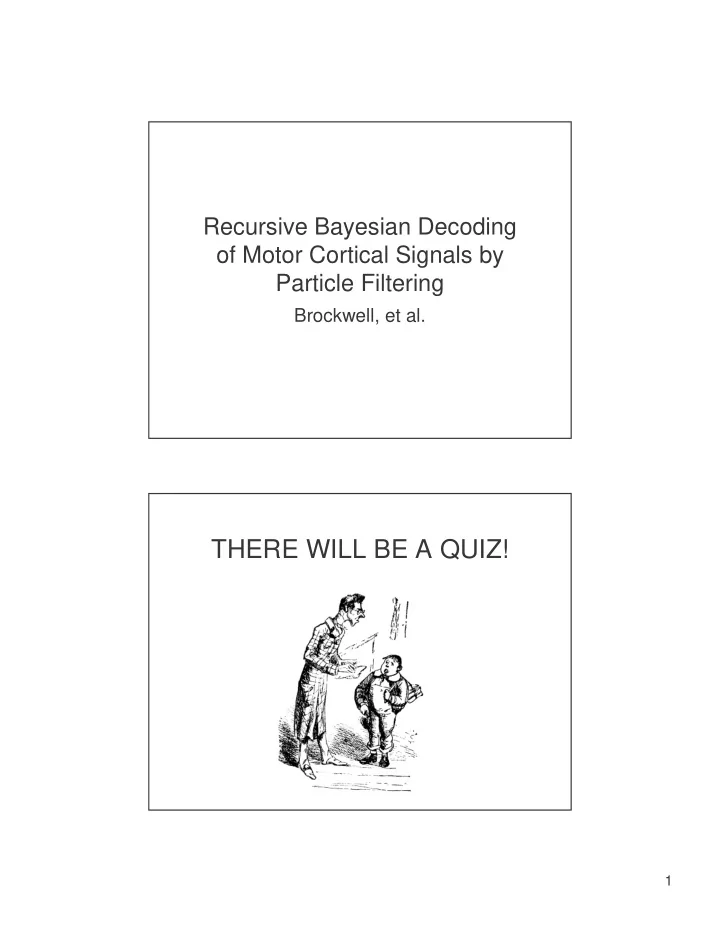

Recursive Bayesian Decoding of Motor Cortical Signals by Particle Filtering Brockwell, et al. THERE WILL BE A QUIZ! 1
Setup • 2 datasets – Simulation – Premotor cortex measurements • 3 methods – PV – Linear Regression (“optimal linear estimation”) – Particle Filter Simulated Dataset • Assume known path • 60 realizations • Tuning functions: (neuron i=1…200 ) – Base firing rate k – Directional sensitivity m – Preferred direction (unit vector) d π π • Half on [0 ], half on [ ] **nonuniform π 2 2 2 2
Real Neuron Measurements • “258 neurons in the subregion of ventral premotor cortex referred to by Gentilucci et al. (1998) as “region F4,” collected individually in 258 separate experiments from four rhesus monkeys” • It’s described in Reina and Schwartz 03 Real Data Collection Setup • Cube corners “center-out” task • subdivide into 100 bins. (Extra credit. How can we stop doing this?) • Ellipse task • Subdivide each of 5 loops into 100 bins • Both tasks: pretend all 258 measurements from one trial, use average velocity as ground truth 3
Population Vector • Velocity at time t • N neurons • Preferred directions d • Weights w (for firing rates y) Optimal Linear Estimation • No assumption of uniformly distributed preferred directions • Salinas and Abbott 94 4
Optimal Linear Estimation • Chose the preferred directions using the known trajectory • I.E. choose d to minimize − T − E v v v v ˆ ˆ [( ) ( )] t t t t • Extra credit: then what did they use for the real data? – See pg 1901: preferred directions obtained using center-out data – but what did they do? Particle Filter 5
Particle Filter (2500 particles) • State model : random walk I • For error i.i.d ~N(0, 0.03 ) • Observation model : for nondirectional sensitivity s Choosing PF parameters • Preferred directions d estimated from center-out task • Everything else from first 3 loops of ellipse task “using standard Poisson-family generalized linear models (McCullagh and Nelder 89)” 6
Lags • Yowzers. For each neuron, used lags yielding the best-fitting generalized linear model Seems like there’s a lot of art to this. 80 chosen by >10 spikes during first 5-loop trial, and having m(directional sensitivity) >.05 Results • Drum roll…. PF wins! Shocked, shocked! • For simulated data, MSE ~10 times smaller than PV and ~5 times smaller than OLE • For real data, ~7 smaller than PV and ~3 times smaller than OLE 7
Real Neuron Results 8
Useful? 10 Times Better MSE == 1/10 Neurons Required? • Where does this come from? • What assumptions implicit in this? 9
Particle Filter PF is general method for conditional density propagation through time P x t z ( | ) We wish we had: t P z x P x ( | ) ( ) = P x z t t t ( | ) Bayes’ Rule: t t P z ( ) t z x For time t, observations , and state or value t t Particle Filter PF is general method for conditional density propagation through time P x t z ( | ) We wish we had: t P z x P x ( | ) ( ) = P x z t t t ( | ) Bayes’ Rule: t t yawn z x For time t, observations , and state or value t t 10
Particle Filter PF is general method for conditional density propagation through time P x t z ( | ) We wish we had: t P z x P x x ( | ) ( | ) = P x z − t t t t 1 ( | ) Bayes’ Rule: t t yawn z x For time t, observations , and state or value t t Particle Filter PF is general method for conditional density propagation through time P x t z ( | ) We wish we had: t ∝ P x z P z x P x x ( | ) ( | ) ( | ) Bayes’ Rule: − t t t t t t 1 z x For time t, observations , and state or value t t 11
Propagate a set of samples drawn from prob. density instead of parameterizing the density Figure: Dieter Fox Dramatis Personae χ = m m x , w Particle Set : t t t For mth particle m = 1 … M m m P x x ‘Kinetic’ or ‘State ( | ) t t − Transition’ Model : 1 w = m m P z x ‘Importance Weights’ or ( | ) t t t ‘Observation Model’: ∝ P x z P z x P x x ( | ) ( | ) ( | ) Posterior: t t t t t t − 1 12
Use weights on samples from kinetic model density to approximate posterior density Figure: Dieter Fox Particles Red of tooth and claw. 13
Particle Filters – Resampling χ w m Draw with replacement M particles from with probability t t Results in new particle set of the same size whose particles more closely represent the posterior Likely to have duplicates, but that’s OK. It’s survival of the fittest! (Like a lion) Particle Filters – State Transition • Apply state transition model to M surviving particles m m P x x ( | ) t t − 1 • Apply observation model w = m m P z x ( | ) t t t • Rinse and repeat 14
• Reina and Schwartz make cool graphics 15
Recommend
More recommend